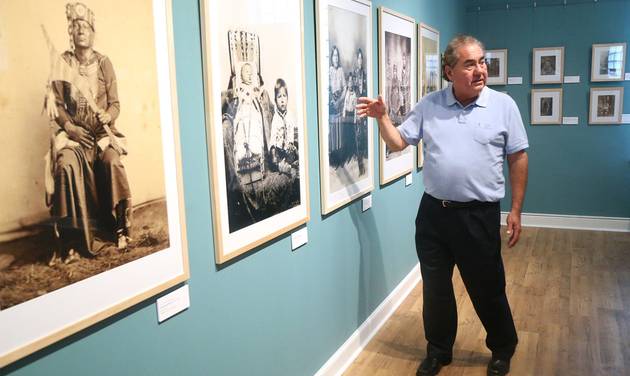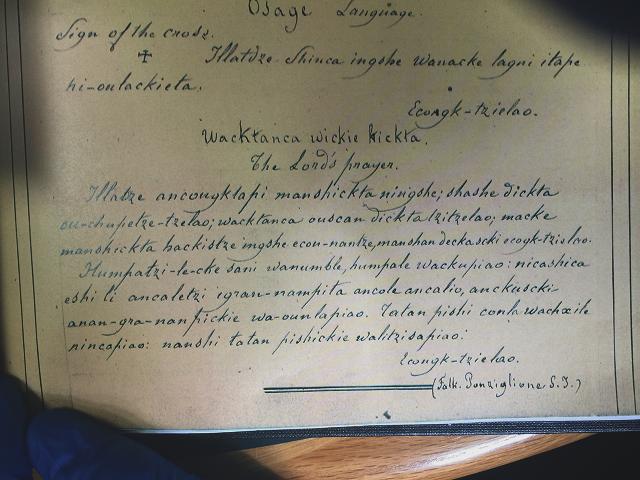 |
Canku Ota
|
 |
|
(Many Paths)
|
||
|
An Online Newsletter
Celebrating Native America
|
||
|
June 2017 - Volume 15
Number 6
|
||
|
|
||
|
Osage Nation Finds
Jesuit Archives Preserving Its History
|
||
|
by John Klein - Tulsa
World
|
||
|
PAWHUSKA — The Osage Nation knew the Jesuits had some documents relating to the history of the tribe. Delving into those papers has brought new revelations. "It was so much more," said Osage Chief Geoffrey Standing Bear. "Many of the documents go to the unknown history of our tribe. It involves stories and legends that we did not know." "This is very important to the Osage. This is our history. Now, we can fill in some of the unknown." The Osage tribe, in conjunction with the Roman Catholic order of priests, has uncovered what Chief Standing Bear called "a treasure trove of documents about the history of our tribe".
The Jesuits and tribe were linked for decades through the Osage Mission, which was established in 1847 and located near what is now St. Paul, Kansas. The documents include translations of the Bible into the Osage language along with stories and legends told by tribal elders to the Jesuits. "Most of these documents are over 100 years old, and some date back as far as the 1700s," said John Williams, a senior advisor to the Osage chief. "It includes works about the story of creation and buffalo hunts and how the Osage language changed over the course of years and years." Standing Bear and Williams knew of the existence of the archive of tribal history and went to see it at the Jesuit of the Missouri Province Archives in a building near St. Louis University. Once they saw the extent of the documents, and their significance, they started the process with the Jesuits to preserve and make a digital copy of the collection. An initial proposal to fund the $90,000 project was turned down by the Osage Nation Congress, but money was found from the Osage Foundation. The papers, some made from onion skin, are currently in Philadelphia, where they are being preserved and copied. "We're looking forward to having papers on display at our museum sometime in the future to further tell the story of our tribe," Standing Bear said. "And, with the digital preservation, any scholar will be able to look at and study the archives on computer. "There's just so much newly discovered information on these papers." The Jesuits "kept meticulous records of everything, and we had a very long relationship with the Jesuits through the Osage Mission," Williams said. "So, we knew there were important documents, but we had no idea how extensive and how much new information we would find." The Jesuits of the Missouri Province created the documents in English, Osage and Latin. The archives include operations, writings, publications, photographs and memorabilia. "These are stories that were passed down from parents and grandparents and told to the Jesuits," Williams said. "There are stories of medicine and hunting the hairy elephants (believed to be woolly mammoths from ancient times)." "These are the stories of our people as they traveled from Missouri to Kansas and eventually here to Oklahoma. It adds to our culture and language." One of the most interesting documents is an Osage translation of the Douay Rheims Bible, an early English version used by the Jesuits during the 1800s. In preliminary study of the Osage language Bible, the tribe is learning more about its language and the way it was transformed and changed over the years.
"It really is interesting to read and see how words changed and how the language changed and seeing new words that we previously didn't know existed," Standing Bear said. "To see these documents is really fascinating." "There is so much of our history that has been lost. This helps to fill in the blanks of the history of our culture. We think that's very important to the future." |
||||
|
|
|
|
||
|
|
||
| Canku Ota is a free Newsletter celebrating Native America, its traditions and accomplishments . We do not provide subscriber or visitor names to anyone. Some articles presented in Canku Ota may contain copyright material. We have received appropriate permissions for republishing any articles. Material appearing here is distributed without profit or monetary gain to those who have expressed an interest. This is in accordance with Title 17 U.S.C. Section 107. | ||
|
Canku Ota is a copyright ©
2000 - 2017 of Vicki Williams Barry and Paul Barry.
|
||
 |
 |
|
|
The "Canku
Ota - A Newsletter Celebrating Native America" web site and
its design is the
|
||
|
Copyright ©
1999 - 2017 of Paul C. Barry.
|
||
|
All Rights Reserved.
|
||

